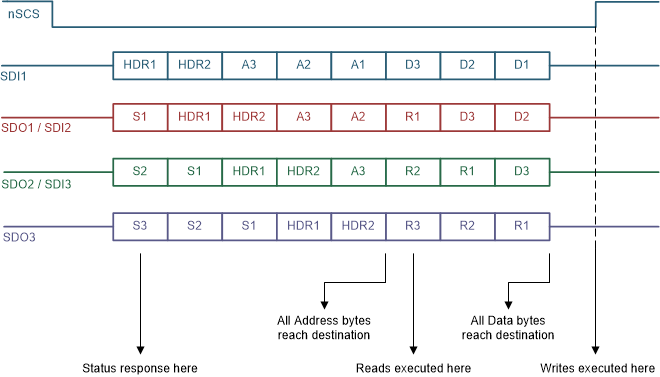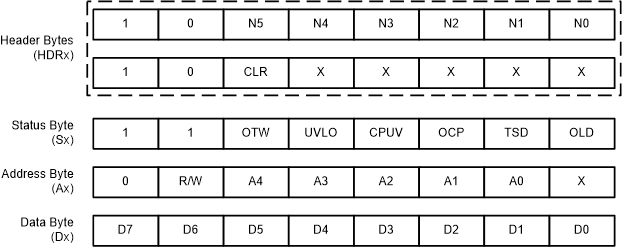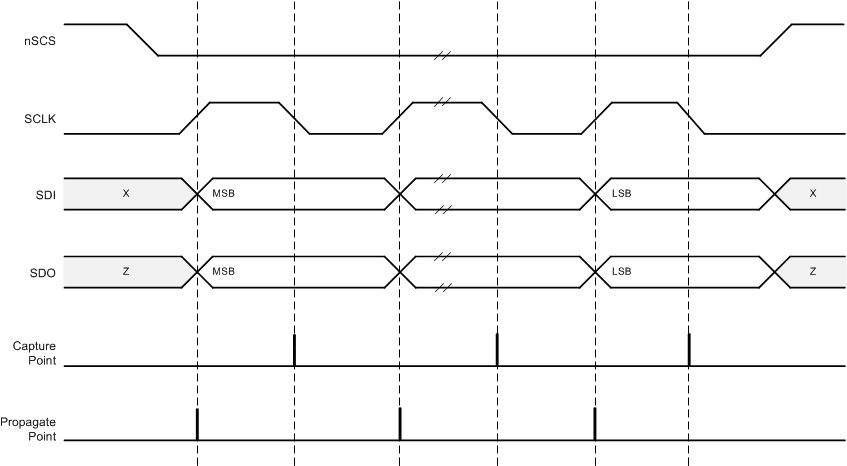SLVSET1 August 2018 DRV8873
PRODUCTION DATA.
- 1 Features
- 2 Applications
- 3 Description
- 4 Revision History
- 5 Pin Configuration and Functions
- 6 Specifications
-
7 Detailed Description
- 7.1 Overview
- 7.2 Functional Block Diagram
- 7.3 Feature Description
- 7.4 Device Functional Modes
- 7.5 Programming
- 7.6 Register Maps
- 8 Application and Implementation
- 9 Power Supply Recommendations
- 10Layout
- 11Device and Documentation Support
- 12Mechanical, Packaging, and Orderable Information
Package Options
Mechanical Data (Package|Pins)
- PWP|24
Thermal pad, mechanical data (Package|Pins)
- PWP|24
Orderable Information
7.5.1.4 SPI for Multiple Slave Devices in Daisy Chain Configuration
The device can be connected in a daisy chain configuration to keep GPIO ports available when multiple devices are communicating to the same MCU. Figure 24 shows the topology when three devices are connected in series.
 Figure 24. Three DRV8873S Devices Connected in Daisy Chain
Figure 24. Three DRV8873S Devices Connected in Daisy Chain The first device in the chain receives data from the MCU in the following format for 3-device configuration: 2 bytes of header (HDRx) followed by 3 bytes of address (Ax) followed by 3 bytes of data (Dx).
 Figure 25. SPI Frame With Three DRV8873S Devices
Figure 25. SPI Frame With Three DRV8873S Devices After the data has been transmitted through the chain, the MCU receives the data string in the following format for 3-device configuration: 3 bytes of status (Sx) followed by 2 bytes of header followed by 3 bytes of report (Rx).
 Figure 26. SPI Data Sequence for Three DRV8873S Devices
Figure 26. SPI Data Sequence for Three DRV8873S Devices The header bytes contain information of the number of devices connected in the chain, and a global clear fault command that will clear the fault registers of all the devices on the rising edge of the chip select (nSCS) signal. Header values N5 through N0 are 6 bits dedicated to show the number of devices in the chain. Up to 63 devices can be connected in series for each daisy chain connection.
The 5 LSBs of the HDR2 register are don’t care bits that can be used by the MCU to determine integrity of the daisy chain connection. Header bytes must start with 1 and 0 for the two MSBs.
 Figure 27. Header Bytes
Figure 27. Header Bytes The status byte provides information about the fault status register for each device in the daisy chain so that the MCU does not have to initiate a read command to read the fault status from any particular device. This keeps additional read commands for the MCU and makes the system more efficient to determine fault conditions flagged in a device. Status bytes must start with 1 and 1 for the two MSBs.
 Figure 28. Contents of Header, Status, Address, and Data Bytes
Figure 28. Contents of Header, Status, Address, and Data Bytes When data passes through a device, it determines the position of itself in the chain by counting the number of status bytes it receives followed by the first header byte. For example, in this 3-device configuration, device 2 in the chain receives two status bytes before receiving the HDR1 byte which is then followed by the HDR2 byte.
From the two status bytes, the data can determine that its position is second in the chain. From the HDR2 byte, the data can determine how many devices are connected in the chain. In this way, the data only loads the relevant address and data byte in its buffer and bypasses the other bits. This protocol allows for faster communication without adding latency to the system for up to 63 devices in the chain.
The address and data bytes remain the same with respect to a 1-device connection. The report bytes (R1 through R3), as shown in Figure 26, are the content of the register being accessed.
 Figure 29. SPI Transaction
Figure 29. SPI Transaction